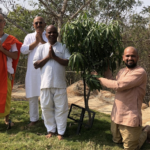A flute, a song, and a mango tree: Sharing seeds of positivity, one step at a time
Through careful grafting, a Pakistani mango tree has bonded with an Indian one at the Peace Hill Garden in Pune, India. How it made its way over is a story worth telling. And the hope is that the seeds of peace will take root just as miraculously.

“The Pakistani chaunsa is now deeply rooted in this land, and now we will have chaunsa and kesar (the Indian variety that was grafted) together. When it bears fruit we will take the mangoes to Pakistan and share them with our friends and even the Pakistani Prime Minister one day.”
Nestled amidst lush landscapes and rolling hills on the outskirts of Pune lies the serene Peace Hill Garden on the banks of Garade River. This sanctuary for the soul is also a hub for botanical experimentation.
During the Coronavirus pandemic, the The Hidden Oasis wellness resort owner Yunusbhai Shipchandler donated about an acre of land to Yogesh, a software engineer-turned-peace activist.
Following the shock of his wife’s passing in January 2005 due to pancreatic cancer, on his 50th birthday Yogesh had left a 30-year lucrative career in the IT industry in the USA and began researching on health and wellness. He then returned to Mumbai, India, focusing on matters of the soul.

Twelve years ago, Yogesh dropped his family surname on noticing people tended to align him with a particular community. He later took on the name VishwaMitra, or friend of the universe.
Yogesh used the land donated by The Hidden Oasis to build a home-ashram, RaviKusum, named after his father Ravindra and mother Kusum. They moved in with Yogesh and his two daughters on the first day of 2022, living in two rooms, reserving the other three for visitors. His father passed away here last year.
In 2022, Yogesh started the Peace Hill Garden, populating it with statues of “those who contributed for peace”, as he puts it. The Garden provides a space for people from diverse cultures and backgrounds to come together in harmony and unity against the backdrop of verdant foliage and blooming flowers. Yogesh estimates that about 4,000 individuals have been here over the past couple of years.
Chaunsa-kesar

Besides statues, the Garden is the site of an interesting living experiment: A five-feet tall ‘kesar’ mango tree planted just beyond a newly installed bust of Kasturba Gandhi, Mahatama Gandhi’s wife.
This is no ordinary ‘kesar’. On 30 January this year, on ‘Shaheed (martyr) Day’, the anniversary of Mahatama Gandhi’s assassination, the ‘kesar’ was grafted with a Pakistani ‘chaunsa’. This is a mouth-wateringly sweet and juicy mango variety, its sapling lovingly brought over by Yogesh and his two fellow peace-walkers in Pakistan, Nitin Sonawane and Jalandharnath Channole. The trio had spent a memorable 24 days there in the summer of 2022.
https://www.instagram.com/p/C2upS7hid7_/?utm_source=ig_web_copy_link&igsh=MzRlODBiNWFlZA==
I was fortunate to be present at the grafting ceremony. Also present was Jayeshbhai Patel, a mentor to the peace yatrees, and head of the Gandhi Sabarmati Ashram north of Ahmedabad, Gujarat, once the residence of Mahatma Gandhi and his spouse Kasturba.
Sonawane, an engineer-turned-peace activist, recalled how as they were leaving Pakistan, Irshad Ahmed of the Humanist Group presented them with a four-feet tall mango tree.
“We decided we would plant it in Pune as a ‘peace tree’,” Sonawane told Sapan News.

How they circumvented the rules that bar the export of trees across national borders is a story in itself – “and this one was a whole four-feet!” he said, smiling.
The Pakistan immigration authorities initially disallowed the yatrees from taking the tree to India.
Sonawane tried to woo the officials by telling them that it was a token of love and peace from brothers on the Pakistan side. The officials were unmoved. Then a pair of eyes fell on the flute Channole always carries. One of the Pakistani officials was also a flautist.
The tense atmosphere melted into one of amity and belonging. The immigration officials agreed to let the tree through, reminding the trio that the Indian immigration officials at the Wagah border would probably confiscate it.
On the Indian side, Channole played the song Vasihnav Jan Te, one of Gandhi’s favourite bhajans or hymns, and the trio also sang their signature Jai Jagat (victory of the world) song, which the officials appreciated whole-heartedly.
That is how the peace-walkers were able to take the mango plant from Punjab, Pakistan, across to India.
“The Pakistani chaunsa is now deeply rooted in this land,” said Sonawane. Once the chaunsa-kesar bear fruit, he added, “We will take the mangoes to Pakistan and share it with our friends and even the Pakistani Prime Minister one day.”
Syncretic
Born and educated in a small town in Maharashtra state, he belongs to a syncretic family of Hindus – his mother accepted Christianity, his father fasted during Ramazan, and one grandmother followed a sect of Sikhism.
The yatrees’ vision includes a plan to graft mangoes from Bangladesh this year. These mango trees will bear ‘the fruit of unity’ with three distinct varieties in a few years. They will be more than just a horticultural marvel- they will be a testament to the people’s aspirations for peace, unity. They will also symbolise the symbiotic relationship between nature and spirituality which can help heal the troubled region.
Yogesh takes inspiration from the Ahmedabad Environmental Sanitation Institute run by his mentor Jayeshbhai Patel. It was the Global Peace Pole inaugurated in 2018 at the Gandhi ashram that inspired the Peace Hill Garden.
He recalls its inauguration, and the busts of Gandhi and Vinoba Bhave, both prominent advocates of nonviolence and human rights, installed there in 2022. In late 2023 they installed a 22-feet Global Peace Pole, “one of the largest in the region.”
In January this year Yogesh and his friends installed the bust of Kasturba Gandhi. They also have a statue of the Buddha and are planning to install busts of Nelson Mandela and Martin Luther King Jr. They hope to inspire people with these symbols and archetypes of peace.
Yogesh told me that he is the only Indian to have walked in Sri Lanka, Bangladesh and Pakistan with his peace message, besides South Africa, UAE, Iran and Armenia – 21,000 kilometres across eight countries without a single penny in his pocket.
Two heart attacks in 2017 temporarily halted his travelling, but he kept going and wants to walk till the very end, he told Sapan News.
Over the past year, he said he has been meditating “15 minutes daily for six categories of people: army, police, farmers, politicians, bureaucrats and judiciary and I find myself at peace. I am going to meditate for these six categories of people in the world and especially in India with elections round the corner.”
Yogesh now plans to go to the USA to ‘plant seeds of peace and positivity’ in this election year. “I want to take this message to the people in the US particularly because I am very grateful to America. It gave me great opportunities.”
At the Peace Garden, I also met Sister Lucy Kurien, the founder of the nonprofit Maher (‘maternal home’ in Marathi) and its President, Hirabegum Mulla. The organisation aims to uplift various communities including women, destitute and the mentally challenged, with a presence in eight states in India.
Humanity
“This is a place for humanity. It is needed for every nation and village,” Sr. Lucy told Sapan News.
“Humanity is the basic foundation. Everything should start from education,” Mulla added.
Peace Hill Garden also has an All Religions Shrine, a testament to the ideals of humanity and transcending religious boundaries.
Also present was Kanshin Ikeda, a Japanese monk who has been travelling across the world spreading the message of peace. He commended Yogesh’s endeavours adding wistfully, “Indians have forgotten Gandhi but Japanese remember Gandhi. Gandhi was Indian but his heart and his thoughts were non-violent.”
He also mentioned Nichidatsu Fujii, a Japanese Buddhist monk and founder of the Nipponzan-Myōhōji order. Looking up Fujii, I learnt that he was inspired by Nichiren Buddhism, a branch of Mahayana Buddhism based on the teachings of the 13th-century Japanese Buddhist priest Nichiren.
Arriving in Calcutta in 1931, Fujii met Mahatma Gandhi in 1933, an experience that left a lasting impact on both. Gandhi, deeply honoured, incorporated Nichiren’s ‘daimoku’ chant into his ashram’s prayers. This encounter laid the foundation for Fujii’s subsequent global initiative of constructing Peace Pagodas for world peace.
The mango-tree grafting ceremony ended with a home-cooked organic feast, a celebration of sustainable living and a harmonious relationship with nature.
From the resonating Buddhist chants to the grafting experiments that brought together trees from different nations, each element contributed to the rich tapestry that transcends race, colour, culture, caste and even national boundaries.
“We have to decide what we want to do. The normal trend is to work for money. I think life is beyond that,” says Nitin Sonawane. Whatever happened in the past is good or bad, he adds, “and many times imaginary”.
“We don’t want to live in the past, we want to live in the present. If people love stories then we should tell them about Gandhi’s story of truth, justice, equality and fight for change. He is my inspiration.”
“We are human beings, and we respect all religions!” beams Yogesh as we part ways.
Based in Pune, Katherine Abraham is an author, legal journalist, and an advocate for peace and human rights who was recently awarded with the prestigious global Rex Karmaveer Silver Award. She is the Associate Editor for India Business Law Journal and an editor-at-large for Red Penguin Books, USA. She is also a research associate for the Indian parliamentarian and former U.N. Under-Secretary General Dr. Shashi Tharoor.






CONNECT WITH US